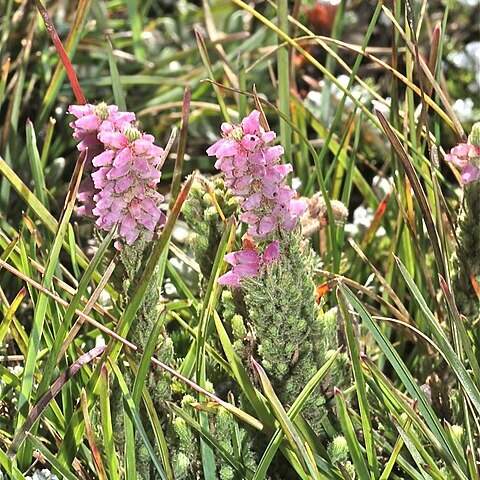Erect shrub up to 30 cm (1 ft) or so. Branches virgate with small and short or minute branchlets, pubescent and setose-hirsute. Leaves 3-nate, 4-6 mm long, incurved-ascending, linear, obtuse, sulcate, coarsely pubescent or hirsute. Flowers terminal, 3-nate, crowded on very short branchlets towards the ends of the branches into a cylindrical false spike up to 15 cm long and 10 mm wide; peduncles less than 1 mm long; bracts remote, small or sometimes larger and foliaceous. Sepals about 2 mm long, linear-subulate, pubescent or setose, setose-tipped, ciliate. Corolla about 3 mm long, broad-ovoid or suburceolate-ovoid, mouth much contracted, pubescent, or glabrous, pink; lobes very short, spreading, obtuse. Filaments capillary; anthers included, 0.4 mm long, lateral, broad-ovate, pale brown, appendiculate; awns nearly as long as the cell, rough. Ovary ovoid, villous; style included, curved; stigma capitate.
Erect shrub to dwarf shrub, 0.3-0.5 m high; compact and tufted. Leaves 3-or 4-nate, erect, incurving; 4-6 mm long, linear; abaxially grooved, midrib visible, covered with coarse hairs. Flowers 3-nate, densely packed at tips of branches in unbranched dense false-spikes, up to 150 x 10 mm; pedicels > 2 mm long; bracts 3, remote, foliaceous. Calyx sepals ± 2 mm long, linear, pubescent or with bristles, ciliate. Corolla 2-6 mm long, urceolate or ovoid, mouth contracted, hairy, pink or white. Filaments capillary; anthers included, ± 0.4 mm long, ovate, aristate, pale brown; appendages short. Ovary ovoid, villous, with fine, relatively short hairs; style included, curved; stigma capitate. Flowering time all year.

